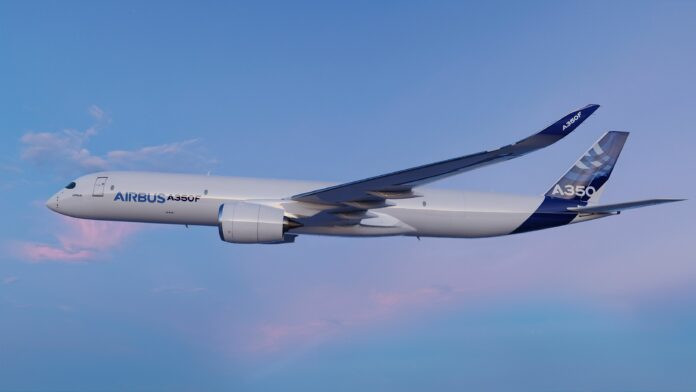

Airbus is making strides in the production of its flagship A350F aircraft, as it looks to change the face of the air cargo industry with its new generation freighter. Bringing the latest developments in terms of efficiency, Airbus looks to present its soon to be rolled out model as the “only choice for the future of the large widebody freighter market.”
The production is now in fully swing, with Airbus having marked a major milestone recently, completing the manufacturing of the first part of the aircraft, showing the development process is in full swing.
“It’s really exciting,” Crawford Hamilton, Head of Freighter Marketing at Airbus, said. “It’s all gradually coming together.”
Striking a balance
With rising demand for the freighters from a number of seven customers so far, Airbus is keen to highlight the industry’s enthusiasm for their offering, with sustainability and fuel efficiency at the core of the aircraft’s design.
“We’re entering a new market. To come in and get that reception from seven customers now is absolutely amazing,” Hamilton added. “It’s a very tough market that our competitor has dominated for years and we want to come in there and start to make a difference.”
“Customers came to us and said ‘we want a choice,’ so this is a good start. The challenge in the days, months and years that are coming is to add to the order number in a substantial manner,” he continued.
The A350F looks to strike the perfect balance between having a high payload capacity, a sustainable set up and an impressive range. Leveraging the already deployed A350 platform, the carbon fibre construction and structural capability of the aircraft ensures reduced weight compared to older freighters.
“You have to pick the right platform. That’s why we picked the A350-1000. It has the capability to be developed into a very good 100 tonne+ freighter,” Hamilton highlighted. “We’ve gone for carbon, which means we’re about 13 tonnes lighter compared to other manufacturers’ current aircraft. With that weight saving and the most efficient engine in service today, you’ve got a great offering.”
This structure, combined with efficient engines and aerodynamics, such as its modern wing design, look to ensure optimal performance when it takes to the skies. Embracing customer preferences and seeking to present a modern alternative to traditional freighters, cargo operators have improved adaptability and flexibility with the A350F.
READ: Teleport unveils a321F
Deadlines and dilemmas
The global supply chain has suffered a series of shocks in recent years, delaying projects beyond their original deadline. Airbus has been mindful of this risk to their delivery dates, taking steps to ensure they are continually monitoring the situation, preparing contingency plans.
“It’s never easy when you’re designing an aircraft. It’s always very challenging but we have a great bunch of engineers. We are always speaking to the customers to make sure we are doing the right thing, so it’s all progressing very well,” Hamilton stated.
While having had to push back the expected delivery of the first A350F to 2026, Airbus is confident that they will be able to keep the project on track.
“There are supply chain challenges but we have a whole procurement department that keeps an eye on that all the time,” Hamilton explained. “Last year, all our widebody aircraft were delivered on time, so the supply chain is very much under control.”
While preventing delays is, arguably, the biggest challenge facing any company in the industry, there is another dilemma facing aircraft manufacturers directly: conversion vs new freighters.
With the airfreight market offering ever growing potential and opportunity for carriers and cargo handlers, Airbus is looking to convince companies that new freighters are the best route forward.
“When you’re looking at converted freighters, I think they’re for different markets. It’s very much horses for courses, particularly with the large aircraft conversions,” Hamilton explained.” “With the new aircraft, you get utilisation and you get reliability, that’s the two big things.”
The A350F doesn’t just look to provide customers with those two factors, but it also has the ability to integrate easily into existing fleets due to its compatibility with other Airbus aircraft.
“Only with an Airbus do you get that. Kind of commonality in the modern market and you get it through all sizes of freighter,” Hamilton said. “That’s the big thing, so you can start to look at more integrated fleets and more integration of pilots.”
READ: EFW redelivers 50th Airbus conversion freighter
State-of-the-art services
Beyond offering the latest technology around sustainability and efficiency, Airbus has placed significant emphasis around digitalisation and technological innovation in the A350F.
“What we want is to have something that can fit into the market, allow things like tracking, ambient condition monitoring and make sure airlines can start to really get the data that they haven’t had before,” Hamilton said.
Aiming to offer seamless integration with existing systems, the new aircraft will provide enhanced tracking and condition monitoring. This data-driven approach will look to aid airlines with the optimisation of their operations, allowing them to explore potential new areas to grow.
“They can enhance their products and start to look at new revenue streams and how they can be more profitable in a volatile market,” Hamilton continued. “Digitalisation is something that we believe can help them with that.










